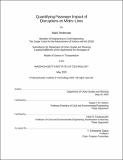Quantifying passenger impact of disruptions on metro lines
Author(s)
Perelmuter, MarkM.C.P.Massachusetts Institute of Technology.
Download1193556205-MIT.pdf (3.198Mb)
Other Contributors
Massachusetts Institute of Technology. Department of Urban Studies and Planning.
Advisor
Nigel H. M. Wilson and Haris N. Koutsopoulos.
Terms of use
Metadata
Show full item recordAbstract
Disruptions occur frequently in urban rail transit systems. Whether due to asset failure, passenger action, weather, or other causes, disruptions often force passengers to change their preferred route or mode, defer their travel to a later time, or avoid making the trip altogether. Researchers and transit network operators have devoted significant time to understanding how passengers respond to disruptions, and modeling the impact that these responses have on the network state. They have also explored many avenues for mitigating the impact of disruptions once they occur. The goal of this research is to understand the effect that infrastructure investments, specifically in track layout, have on mitigating the impact of major disruptions, and to model the effect of these disruptions by developing a simplified passenger assignment model, which aims to accurately represent the impact of a major disruption, such as a partial line suspension, on a transit network while having a sufficiently short computation time to be useful for sketch planning and similar first-order alternatives analysis. Both parts of the work are applied to the London Underground, specifically the Piccadilly line, as a case study. The track layout analysis framework outlines a method to determine optimal locations for new track crossovers and compute the benefit that they have on reducing the impacts of unplanned partial line suspensions, or planned closures, by allowing trains to operate over a greater portion of the affected line. This benefit is then used as an input to a business case, which finds that, for the categories of benefit considered, investment in track layout enhancements on the Piccadilly Line is not justified. The simplified assignment model strikes a balance between accurately representing the behavior of passengers during unplanned disruptions, specifically the difference between expected and experienced network state that is characteristic of these disruptions, and keeping the scope of the model sufficiently small to ensure quick computation time. Despite the model's simplifications, its results show promise in accurately representing the state of the network during a disruption, and identifying the most overcrowded links on a network, while having a computation time shorter than that of existing models.
Description
Thesis: S.M. in Transportation, Massachusetts Institute of Technology, Department of Urban Studies and Planning, May, 2020 Cataloged from the official PDF of thesis. Includes bibliographical references (pages 115-120).
Date issued
2020Department
Massachusetts Institute of Technology. Department of Urban Studies and PlanningPublisher
Massachusetts Institute of Technology
Keywords
Urban Studies and Planning.